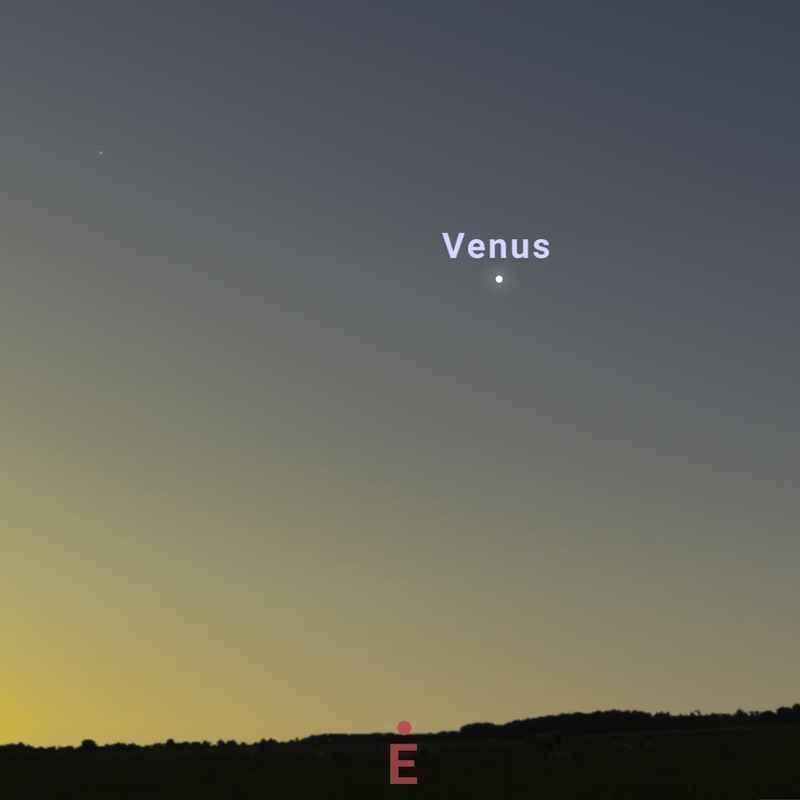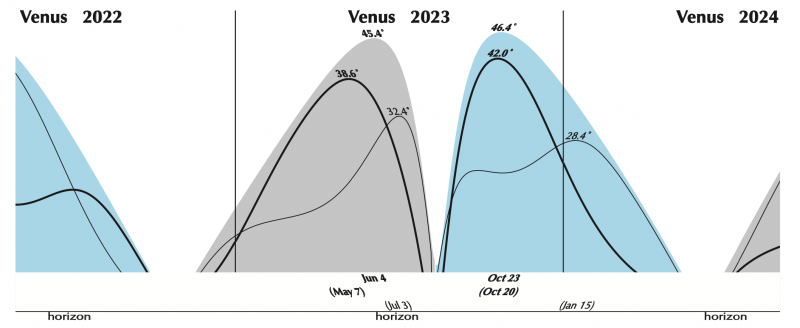
Venus will be farthest from the sunrise on May 31, 2025.
When to watch: Venus raced between the Earth and sun in March 2025, and then it emerged quickly in the east before sunrise. It’ll remain visible in the morning sky until around October 2025. Greatest elongation – when Venus will be farthest from the sunrise – will be May 31, 2025, (0:02 UTC on June 1).
Where to look: Look in the sunrise direction while the sky is still dark or just getting light. Venus is super bright and high above the sunrise point! It’s the glorious “morning star.”
Greatest elongation is at 0:02 UTC on June 1, 2025, (source: AstroPixels). Venus’s distance from sun on the sky’s dome is 45.9 degrees.
Greatest elongation magnitude: Venus shines with dazzling brightness at magnitude -4.3.
Through a telescope: Venus appears 49% illuminated, in a 3rd quarter phase, 23.92″ arcseconds across.
Note: As the sun’s 2nd planet, Venus is bound by an invisible tether to the sun in our sky. It’s always east before sunrise, or west after sunset (never overhead at midnight). Venus is the brightest planet visible from Earth and shines brilliantly throughout every morning or evening apparition. Greatest elongation happens when Venus is farthest from the sun on the sky’s dome. At the May 2025 greatest elongation, Venus will appear higher in the sky from the Southern Hemisphere than from the Northern Hemisphere due to the steep angle of the ecliptic (path of the sun, moon and planets) on spring mornings.
Venus from different hemispheres
We all see the same sky. But our perspective on the sky – from our various parts of Earth – is different. The ecliptic is the apparent path of the sun through our sky. The major planets and moon are found along the ecliptic. So while all of us see Venus in the morning sky now, Southern Hemisphere dwellers see it gloriously high above the sunrise point, while those in the Northern Hemisphere have a less-than-glorious view of the brightest planet. See the chart below to see what we mean …

For precise sun and Venus rising times at your location:
Old Farmer’s Almanac (U.S. and Canada)
timeanddate.com (worldwide).
Stellarium (free online planetarium program)
Venus among the stars

A comparison of elongations
As hinted at above, morning elongations of Venus (or Mercury) are best around the autumn equinox (around September for the Northern Hemisphere, around March for the Southern Hemisphere). These elongations, called western elongations because Venus is west of the sun, happen when the ecliptic – path of the sun, moon and planets – makes a steep angle to the morning horizon. A steep ecliptic angle keeps the planets more directly above the sunrise or sunset.
Springtime elongations that occur in the morning (around March for the Northern Hemisphere, around September for the Southern Hemisphere) are less glorious because of the shallow angle of the ecliptic. When the ecliptic makes a shallow angle with respect to the horizon, that angle keeps the planets closer to the bright sun’s rays.

How far can Venus be from the sun?
The farthest from the sun that Venus can ever appear on the sky’s dome is about 47.3 degrees. On the other hand, the least distance is around 45.4 degrees.

Venus events, 2023-2024
June 4, 2023: Greatest elongation (evening)
August 13, 2023: Inferior conjunction (races between Earth and sun)
October 23, 2023: Greatest elongation (morning)
June 4, 2024: Superior conjunction (passes behind sun from Earth)
By the way, there are no greatest elongations of Venus in 2024. The next evening greatest elongation is January 9, 2025. And the next morning greatest elongation is May 31, 2025.
Bottom line: Look for Venus before sunrise. It’ll reach greatest elongation – its greatest distance from the sunrise – on October 23, 2023. It’s blazingly bright! Can’t miss it!











